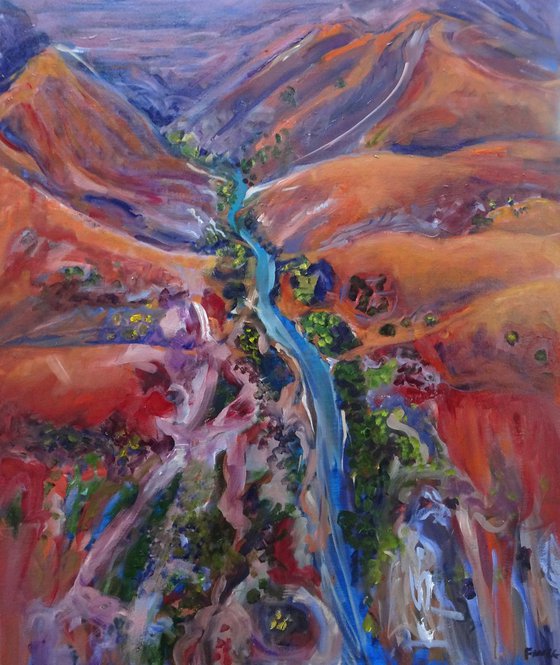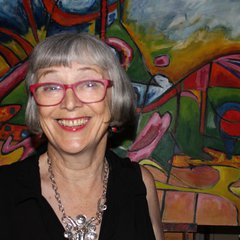- By medium
- By subject
- By budget
- Sales
- Gift cards
- Discover all art
- Artists
- Editors’ picks
- Ideas
Original artwork description:
This painting Flinders Landscape, was inspired by one of the most beautiful landscapes in South Australia.
The Flinders Ranges are the largest mountain range in South Australia, which starts about 200 km (125 mi) north of Adelaide. The discontinuous ranges stretch for over 430 km (265 mi) from Port Pirie to Lake Callabonna, where in 1946 some of the oldest fossil evidence of animal life was discovered.
The first humans to inhabit the Flinders Ranges were the Adnyamathanha people (meaning "hill people" or "rock people") whose descendants still reside in the area. Cave paintings, rock engravings and other artefacts indicate that the Adnyamathana and Ndajurri lived in the Flinders Ranges for tens of thousands of years. Occupation of the Warratyi rock shelter dates back approximately 49,000 years
Since the eradication of dingos and the establishment of permanent waterholes for stock, the number of red kangaroos, western grey kangaroos and wallaroos in the Flinders Ranges has increased. The yellow-footed rock-wallaby, which neared extinction after the arrival of Europeans due to hunting and predation by foxes, has now stabilised.
In the 1830’s, the first European explorers were an exploration party from Matthew Flinders' seagoing visit to upper Spencer Gulf aboard HMS Investigator.
During the 1850’s pastoral leases were granted, and squatters set up sheep stations. Wheat farming was established, but due to unreliable rainfall, was mostly unsuccessful.
Materials used:
oil paint
Tags:
#orange landscape #australian landscape #australian bush #flinders ranges #expressionist australianFlinders Landscape (2019) Oil painting
by Maureen Finck
13 Artist Reviews
£252.13 Sold
- Oil painting on Canvas
- One of a kind artwork
- Size: 76 x 91 x 3.75cm / 76 x 91cm (actual image size)
- Ready to hang
- Signed on the front
- Style: Expressive and gestural
- Subject: Landscapes, sea and sky
Do you like this artwork?
This artwork has sold, but the artist is accepting commission requests. Commissioning an artwork is easy and you get a perfectly personalised piece.
Loading
Original artwork description
This painting Flinders Landscape, was inspired by one of the most beautiful landscapes in South Australia.
The Flinders Ranges are the largest mountain range in South Australia, which starts about 200 km (125 mi) north of Adelaide. The discontinuous ranges stretch for over 430 km (265 mi) from Port Pirie to Lake Callabonna, where in 1946 some of the oldest fossil evidence of animal life was discovered.
The first humans to inhabit the Flinders Ranges were the Adnyamathanha people (meaning "hill people" or "rock people") whose descendants still reside in the area. Cave paintings, rock engravings and other artefacts indicate that the Adnyamathana and Ndajurri lived in the Flinders Ranges for tens of thousands of years. Occupation of the Warratyi rock shelter dates back approximately 49,000 years
Since the eradication of dingos and the establishment of permanent waterholes for stock, the number of red kangaroos, western grey kangaroos and wallaroos in the Flinders Ranges has increased. The yellow-footed rock-wallaby, which neared extinction after the arrival of Europeans due to hunting and predation by foxes, has now stabilised.
In the 1830’s, the first European explorers were an exploration party from Matthew Flinders' seagoing visit to upper Spencer Gulf aboard HMS Investigator.
During the 1850’s pastoral leases were granted, and squatters set up sheep stations. Wheat farming was established, but due to unreliable rainfall, was mostly unsuccessful.
Materials used:
oil paint
Tags:
#orange landscape #australian landscape #australian bush #flinders ranges #expressionist australian14 day money back guaranteeLearn more

